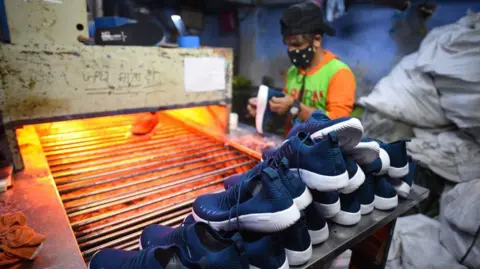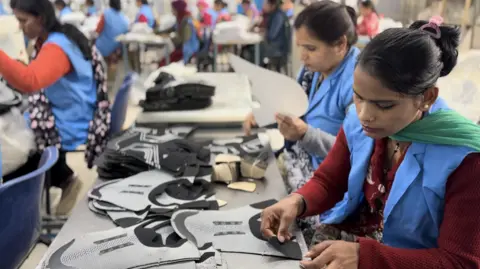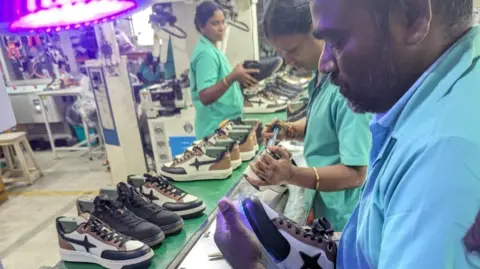A revolution continues in India’s instructor industry

Technology reporter
 Getty Images
Getty ImagesYou probably haven’t heard of Taiwan’s Hong Fu Industrial Group, but look at a busy street and you can see the products well.
Hong Fu, Nike, Converse, Adidas, Puma and others, the world’s second largest instructor manufacturer (sneakers). About 200 million pairs of sneakers annually.
Therefore, when he made a big investment in the Indian market, the shoe industry took notes.
Hong Fu is currently building a giant plant in Tamil Nadu in Panapakkam, South East India. In the event of a completely operation, within the next three to five years, he will make 25 million pairs of shoes a year and employ up to 25,000 workers.
In the project, there are Indian partners, including the president of the Florence Shoe Company, Aqeel Panar: “International market saturated and they [Hong Fu] They were looking for a new market ..
“There is a harsh increase in non -leather shoes in India. It has a great potential.”
The Indian government is eager to attract such an investment, hoping that it will increase the standards and increase exports in the shoe industry.
In order to encourage the industry, the Indian Standards Office (BIS) introduced new quality rules for all shoes sold in India in last August.
For example, under these standards, it will have to pass the power and flexibility tests of materials.
“These BIS standards are really about cleaning the market. We have too much low quality products and consumers deserve better,” Sandep Sharma says.

However, many of them cannot buy shoes from well -known brands in India.
Service to them is a large and complex small shoe manufacturers known as the unprocessed sector.
It is estimated that the total shoe market of affordable products will take into account two -thirds.
Ashok (hiding his full name) counts himself as a part of this sector and makes shoe units in the Agra region in Northern India. It estimates that 200,0000 pairs of shoes are made every day by operations like Agra.
“Many consumers, especially in rural and low -income urban areas, prefer cheaper local shoes instead of branded options,” he says.
“Many organized brands are struggling to expand their retail footprints in semi -urban and rural areas because we address them.”
How will the new government standards affect producers like Ashok?
“Complex,” says Mr. Sharma.
“I think the government is trying to walk on a rope here. They can’t close thousands of small businesses that employ millions of people – this is economic suicide.
“What I see is more of a carrot and a rod approach. They force them for standards, but they also use programs to help small manufacturers raise their processes. This is not about destroying the unorganized sector, but slowly about folding them.”
Making the situation more complex reputed Making fake shoes of big brands.
Although popular among Indian shopping looking for a stylish bargaining, other countries Have long complaints About the cause losses.
 Zen Yalınayak
Zen YalınayakMeanwhile, a series of new Indian coach manufacturers are revealed to serve the growing middle class of India.
Sabhib Agrawal, these buyers are trying to concern lean shoes – the producers, natural or lean moving movement to encourage the foot, he said they are healthy for the foot.
Agrawal says that most of the company Zen Barefoot’s Indian shoe industry is not very innovative.
“There are very few people who are ready to take time and invest in new technologies. Indian manufacturing is very profitable- the first market, investment return [return on investment] drilled.
“And in many cases, even the government is not ready to activate these industries through grants or tax reduction, which makes it very difficult.”
The comet is an Indian company that wants to innovate.
He claims that it is the first house trained in the first house that has the whole production process from design to production.
“This control level allows us to try with innovative silhouettes, and constantly improve comfort and suitability based on real feedback,” the founding Utkarsh Gupta said. Says.
He says comets are adapted to India’s climate and paths.
“Most of the brands grown at home rely on ready -made bases from the market, but when we start Cometring, we noticed that they are missing quality, durability and comprehension,” he says.
Change is coming to the shoe industry. “The transition to high value is now happening.”
“Many high valuable brands need to move their production to India. We must have a solid ecosystem to compete in the international sneakers market in 3-5 years.”
 Comet
CometIn Agra, Ashok hopes that the unprocessed sector will not be neglected between India’s growth of shoe industry.
“The government should give us accreditation and certificates, so our factories do not close. After we are included in the organized sector, no one can defeat India in the shoe manufacturing industry.”
However, Mr. Sharma says that change is inevitable.
“The market will definitely change. We will see larger players grow – they have money to adapt quickly.
“But I don’t think the little men will be completely lost. The smart ones will find their niches.”




